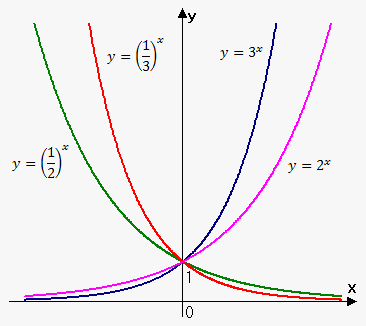Exponential Function
A function of the form $$${f{{\left({x}\right)}}}={{a}}^{{x}}$$$, where $$${a}>{0}$$$, is called an exponential function.
Do not confuse it with the power function $$${f{{\left({x}\right)}}}={{x}}^{{a}}$$$ in which the variable is the base.
The domain of the exponential function is $$${\left(-\infty,\infty\right)}$$$, and the range is $$${\left({0},\infty\right)}$$$, provided $$${a}\ne{1}$$$.
If $$${a}={1}$$$, we have that $$${f{{\left({x}\right)}}}={{1}}^{{x}}={1}$$$.
Exponential functions are useful for modeling many natural phenomena such as population growth (if $$${a}>{1}$$$) and radioactive decay (if $$${0}<{a}<{1}$$$).
Let's see what is meant under $$${f{{\left({x}\right)}}}={{a}}^{{x}}$$$.
If $$${x}={n}$$$, where $$${n}$$$ is a postive integer, we have that $$${{a}}^{{n}}=\underbrace{\left({a}\cdot{a}\cdot\ldots\cdot{a}\right)}_{{{n}}}$$$.
If $$${x}={0}$$$, it can be stated that $$${{a}}^{{0}}={1}$$$, and if $$${x}=-{n}$$$, where $$${n}$$$ is a positive integer, we have that $$${{a}}^{{-{n}}}=\frac{{1}}{{{{a}}^{{n}}}}$$$.
If $$${x}$$$ is a rational number, $$${x}=\frac{{p}}{{q}}$$$, where $$${p}$$$ and $$${q}$$$ are integers, it can be stated that $$${{a}}^{{x}}={{a}}^{{\frac{{p}}{{q}}}}={\sqrt[{{q}}]{{{{a}}^{{p}}}}}={{\left({\sqrt[{{q}}]{{a}}}\right)}}^{{p}}$$$.
There are three kinds of exponential functions:
- If $$${0}<{a}<{1}$$$, the exponential function decreases.
- If $$${a}={1}$$$, the exponential function is constant.
- If $$${a}>{1}$$$, it increases (the bigger $$${a}$$$, the more rapidly it increases).

Properties of exponents.
If $$${a}$$$ and $$${b}$$$ are positive numbers, and $$${x}$$$ and $$${y}$$$ are any real numbers, it can be stated that:
- $$${{a}}^{{{x}+{y}}}={{a}}^{{x}}{{a}}^{{y}}$$$
- $$${{a}}^{{{x}-{y}}}=\frac{{{{a}}^{{x}}}}{{{{a}}^{{y}}}}$$$
- $$${{\left({{a}}^{{x}}\right)}}^{{{y}}}={{a}}^{{{x}{y}}}$$$
- $$${{\left({a}{b}\right)}}^{{x}}={{a}}^{{x}}{{b}}^{{x}}$$$
Applications of exponential functions.
As stated above, exponential functions are widely used in growth/decay problems.
Example 1. Suppose that the initial population of some bacteria is 100. It is known that every 1 hour the population triples. Find the population after 10 hours.
If the number of bacteria at a time $$${t}$$$ is $$${p}{\left({t}\right)}$$$, where $$${t}$$$ is measured in hours, and $$${p}{\left({0}\right)}={100}$$$ is the initial population, we have that
$$${p}{\left({1}\right)}={3}{p}{\left({0}\right)}={300}$$$
$$${p}{\left({2}\right)}={3}{p}{\left({1}\right)}={3}\cdot{3}\cdot{p}{\left({0}\right)}={{3}}^{{2}}{p}{\left({0}\right)}={900}$$$
$$${p}{\left({3}\right)}={3}{p}{\left({2}\right)}={3}\cdot{3}\cdot{3}\cdot{p}{\left({0}\right)}={{3}}^{{3}}{p}{\left({0}\right)}={2700}$$$
$$${p}{\left({4}\right)}={3}{p}{\left({3}\right)}={3}\cdot{3}\cdot{3}\cdot{3}\cdot{p}{\left({0}\right)}={{3}}^{{4}}{p}{\left({0}\right)}={8100}$$$.
Do you see the pattern? It seems that $$${p}{\left({t}\right)}={100}\cdot{{3}}^{{n}}$$$.
So, $$${p}{\left({10}\right)}={100}\cdot{{3}}^{{{10}}}={5904900}$$$.
Now, let's proceed to another example.
Example 2. Suppose that the half-life of some radioactive element is 3 years (recall that the half-life is the amount of time needed to disintegrate a half of any quantity initially presented). Suppose that the initially presented mass is 1000 mg. Find the mass after 10 years.
If $$${m}{\left({t}\right)}$$$ is the mass of the element at any time $$${t}$$$ measured in years, we have that
$$${m}{\left({0}\right)}={1000}$$$
$$${m}{\left({3}\right)}=\frac{{1}}{{2}}{m}{\left({0}\right)}={500}$$$
$$${m}{\left({6}\right)}=\frac{{1}}{{2}}{m}{\left({3}\right)}=\frac{{1}}{{{2}}^{{2}}}{m}{\left({0}\right)}={250}$$$
From this pattern, we can conclude that
$$${m}{\left({t}\right)}=\frac{{1}}{{{{2}}^{{\frac{{t}}{{3}}}}}}\cdot{1000}={1000}\cdot{{2}}^{{-\frac{{t}}{{3}}}}$$$.
So, in 10 years, there will be $$${m}{\left({10}\right)}={1000}\cdot{{2}}^{{-\frac{{10}}{{3}}}}\approx{99.21}$$$ mg.
